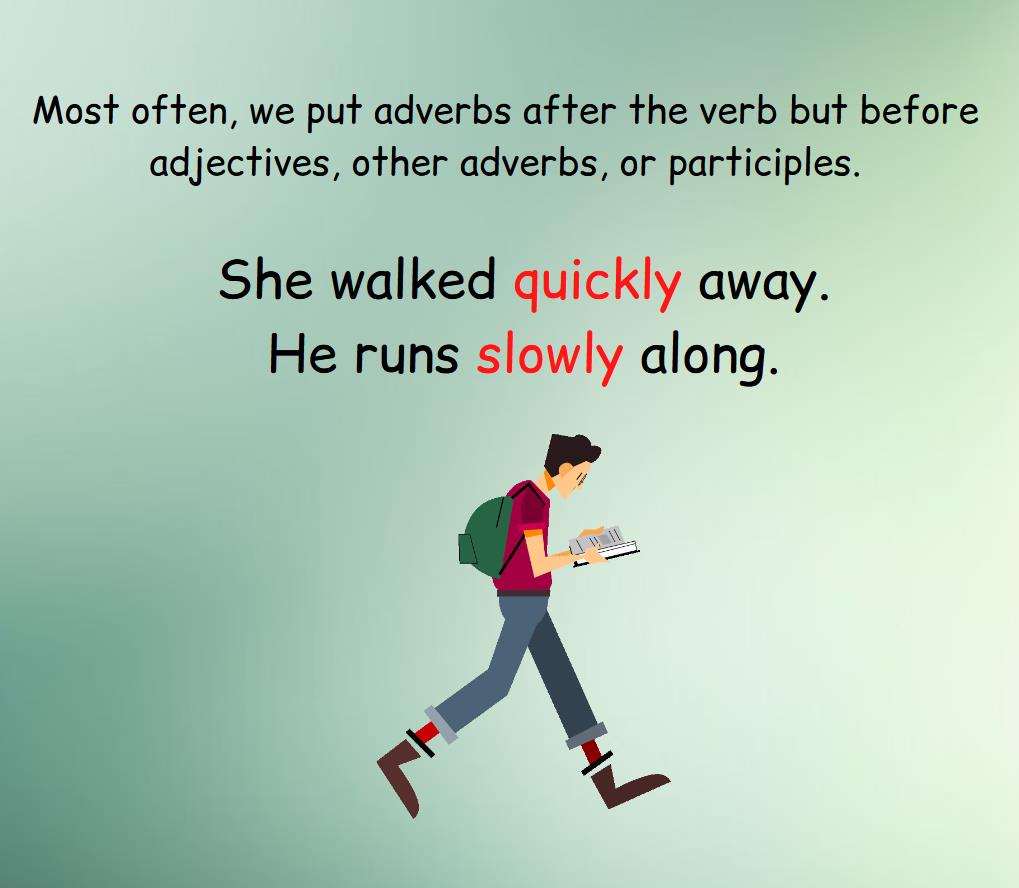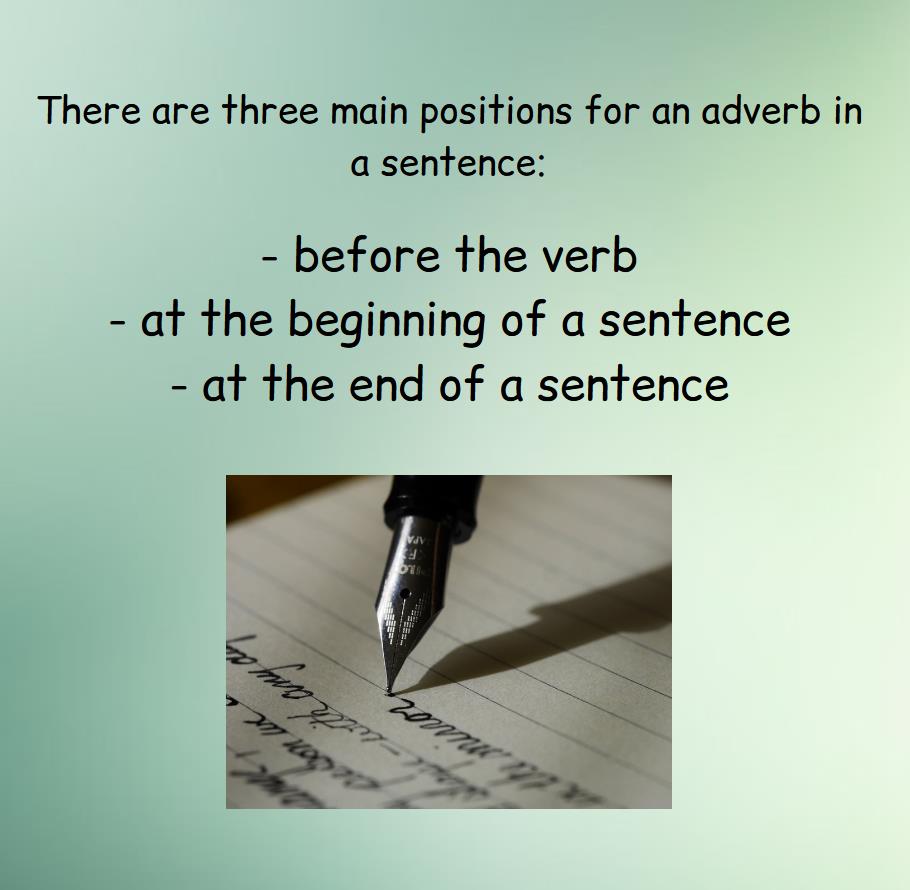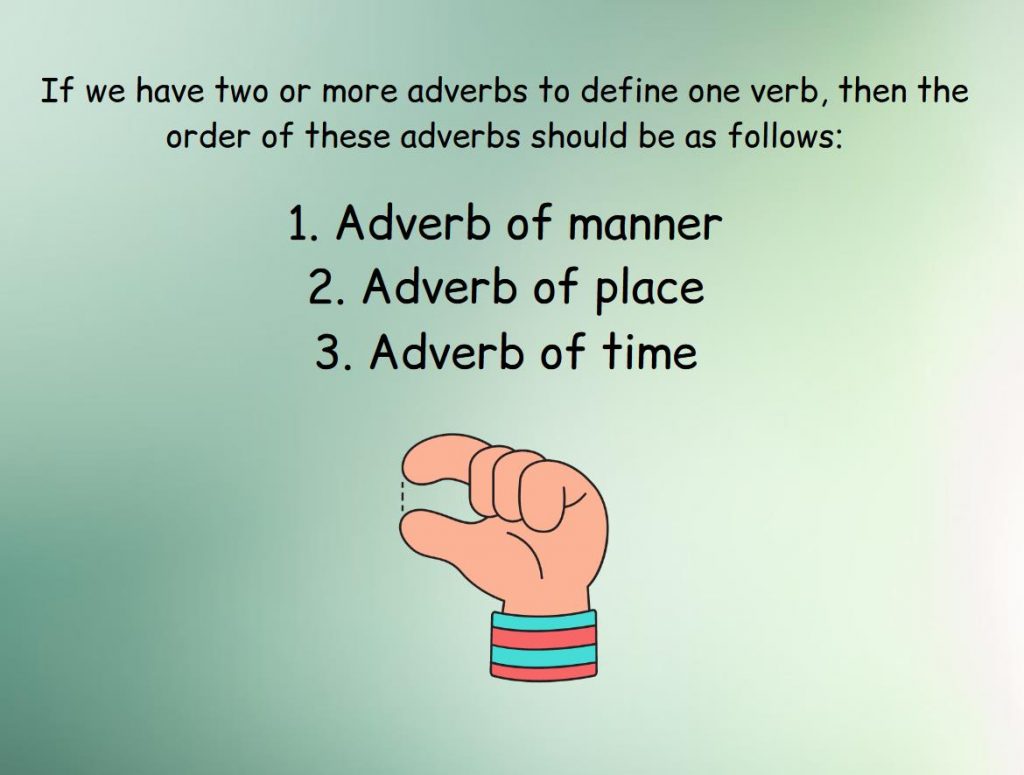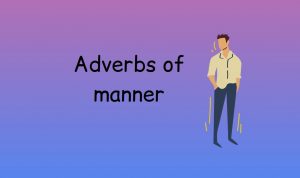Adverbs can take different positions in a sentence. It depends on the type of sentence and on what role the adverb plays and what words the adverb defines, characterizes, describes.
Most often, we put adverbs after the verb but before adjectives, other adverbs, or participles.
She walked quickly away.
He runs slowly along.

Adverb and three main positions
There are three main positions for an adverb in a sentence:
- before the verb
- at the beginning of a sentence
- at the end of a sentence

Let’s look at these positions separately.
At the end
We put an Adverb at the end of a sentence after the predicate and the object.
The water is rising fast.
At the beginning
We put an adverb at the beginning of a sentence before the subject.
Today I have a piano lesson.

In the middle
Most often, we put an adverb in the middle of a sentence. But “middle” is not an accurate concept. Where exactly this middle is located, it depends on the words next to which we use the adverb.
- In interrogative sentences, we put an adverb between the subject and the main verb.
Did he often go out like that?
- If the predicate in the sentence is only one verb, then we put the adverb before the verb.
You rarely agree with me.
- If the predicate contains more than one word, then we put the adverb after the modal verb or after the auxiliary verb (if there is a modal verb or auxiliary verb).
You must never do this again.
There are adverbs that we can put before a modal verb or an auxiliary verb.
He surely can prepare for this.
Adverb placement depending on the type of adverb
The place of an adverb depends on what type of adverbs it belongs to. Different adverbs can appear in different places.
Adverbs of manner
We usually use Adverbs of manner:
- before main verbs
- after auxiliary verbs
- at the end of the sentence
- If the verb is in the Passive Voice, then we use an adverb between the auxiliary verb and the verb in the third form.
- We usually use Adverbs of manner after the verb or after the Object.
- We can NOT use an Adverb of manner between the verb and direct object. If the sentence has a verb and a direct object, then we use an adverb of manner before the verb or after the object.
- Usually we put an adverb of manner that answers the question HOW after the verb or after the verb and the object.
She held the baby gently.
We are running slowly.
- We usually put the adverbs well, fast, quickly, immediately, slowly at the end of a sentence.
I wrote him an answer immediately.
The truck picked up speed slowly.
Adverbs of Frequency
Adverbs of frequency are adverbs that indicate how often, with what frequency an action occurs.
Adverbs of frequency answer the question “How often?“
- Most often we put Adverbs of frequency before the main verb.
- We can use normally, occasionally, sometimes, usually at the beginning of a sentence or at the end of a sentence.
- We usually put Adverbs of frequency that accurately describe the time (weekly, every day, every Saturday) at the end of a sentence.
We have another board meeting on Monday.
I wish we could have fried chicken every week.
Maybe we could do this every month.
- We put Adverbs of frequency after the verb to be if the sentence contains the verb to be in the form of Present Simple or Past Simple.
My routine is always the same.
- We often use usually, never, always, often, sometimes, ever, rarely in the middle of a sentence.
I often wish I knew more about gardening.
- We can use usually at the beginning of a sentence.
Usually, I keep it to myself.
Adverbs of degree
Adverbs of degree express the degree to which something is happening. These are such adverbs as:
- almost
- absolutely
- completely
- very
- quite
- extremely
- rather
- just
- totally

- We put Adverbs of degree in the middle of a sentence.
- We put Adverbs of degree after Auxiliary Verbs.
- We put Adverbs of degree after modal verbs.
I feel really guilty about that.
- We put Adverbs of degree before adjectives.
When guns speak it is too late to argue.
- We put Adverbs of degree before other adverbs.
He loses his temper very easily.
- Sometimes we put Adverbs of degree before modal verbs and before auxiliary verbs. Usually, we use such adverbs as:
- certainly
- definitely
- really
- surely
You definitely could have handled things better.
I think I really could have won.

- The adverb enough is an exception to this rule. We put the Adverb enough after the word it characterizes.
I have lived long enough.
Adverbs of place and time
Let’s see where we use the adverbs of place and adverbs of time.
- Most often we put the adverb of place and time at the end of the sentence.
I thought you didn’t have family nearby.
They found her place in Miami yesterday.
- We put monosyllabic adverbs of time (for example, such as now, then, soon) before main verbs but after auxiliary verbs including the verb to be.
Now imagine you see another woman.
Yes, he is now a respectable man.
- We can use adverbs of place and time at the very beginning of a sentence when we want to make the sentence more emotional.
Today, we have to correct his mistakes.
- We put the adverbs here and there at the end of the sentence.
Independent thought is not valued there.
- Most often we put adverbs of place and time after the verb or verb + object.
I can’t change what happened yesterday.
You have to attend my wedding next month.
- Most often we put such adverbs as towards, outside, backward, everywhere, nearby, downstairs, southward, at the end of the sentence or in the middle of the sentence, but immediately after the verb.
I made iced tea and left it downstairs.
With this speaker, you can hear everything outside.
I can run backward!
- We put adverbs of time that accurately define the time (for example, yesterday, now, tomorrow) at the end of the sentence.
The ship is going to be back tomorrow.
He wants it to happen now.
If we want to emphasize time, we can put an adverb that accurately specifies the time at the beginning of the sentence.
Tomorrow I’m moving to Palais Royal.
Adverbs that show the speaker’s degree of confidence.
Let’s talk about the place in the sentence occupied by Adverbs that show the speaker’s degree of confidence in what the speaker is saying.
- We can put at the beginning of the sentence such adverbs as:
- definitely
- perhaps
- probably
- certainly
- clearly
- maybe
- obviously
Certainly, you have an opinion about that.
Definitely think twice before correcting one of your mistakes again.
Maybe someone else was in her apartment that night.
We can also put adverbs like this in the middle of a sentence:
They’ll probably name a street after me.
This assumption is clearly no longer valid.

Adverbs that emphasize the meaning of the word they describe
The next group of adverbs is adverbs that emphasize the meaning of the word they describe.
- Look at the following adverbs:
- very
- really
- terribly
- extremely
- almost
- quite
- pretty
We usually put such adverbs in the middle of the sentence before the word that these adverbs characterize.
He is very tired.
She found it extremely difficult to get a job.
I’m quite happy to wait for you here.
Adverbs defining a verb
- We put an adverb after the verb to be. If the adverb defines the verb to be in one of its forms.
He was never a good man.
- If an adverb defines another adverb or adjective, then we put such an adverb most often before the word that it defines.
I can see it quite clearly.
They walked rather slowly.
Adverbs connecting sentences
Adverbs can connect sentences in a logical sequence.
Such adverbs can appear at the beginning of the sentence or in the middle of the sentence. These are such adverbs as:
- next
- anyway
- however
- besides
- next
Adverbs that explain the speaker’s point of view
Let’s take a look at Adverbs that explain the speaker’s point of view in what he says.
- fortunately
- surprisingly
- personally
We most often put them at the beginning of the sentence.
Honestly, I wish I had time to do more reading.
Often their homes are their only major material possession.
We can put some of these adverbs at the end of a sentence.
I know what you’ve done for me, honestly.
Always, Never, and Only
Now let’s talk about some adverbs separately. These are very popular adverbs that we often use in English.
- Always and never.
We usually put always and never in the middle of the sentence before the verb they define.
The bread always falls buttered side down.
Love is never paid but with true love.
- Only.
Only is an incredibly popular adverb. Most often, we put only before the word that the adverb only characterizes.
Wisdom is only found in truth.
A man can only die once.
Additional tips
If we have two or more adverbs to define one verb, then the order of these adverbs should be as follows:
- Adverb of manner
- Adverb of place
- Adverb of time

Did I help you? Buy me a coffee 🙂
Hello! If you would like to thank me for the articles I wrote, you can click Buy me a coffee. Thank you! ❤❤❤











Keep this going please, great job!